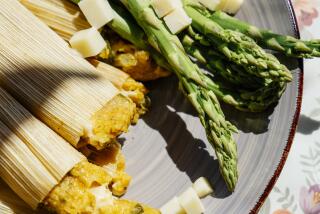Basking in Basque culture
- Share via
Reporting from Boise, Idaho — For high school senior Alex Wray, there’s no stigma to his membership in a troupe that performs traditional old-world peasant dances. The 17-year-old also is an offensive lineman, but he said his varsity football teammates never razz him about his primary passion: dancing with the young adults of the Oinkari company.
In many communities, the harmonious mix of arts and athletics could be attributed to “Glee.” In Boise, thank the Basques.
“My mom is Basque,” Alex said, referring to Basque Country, the small, semi-autonomous chunk of land straddling the border of Spain and France. “[The dancing] is just part of what I grew up around.”
In the Idaho capital, a city of about 200,000, nearly one in 10 residents is thought to have Basque ancestors. It has one of the largest Basque populations in the United States, which explains the presence of several restaurants, a heritage center, a museum and a market embracing Basque traditions.
They’re all on what is known as the Basque Block on Grove Street in downtown Boise. The Basque Museum & Cultural Center is a good starting point to understand how so many people from such a small place ended up in Boise.
“If you could pick up [Basque Country] and put it in our state, it would fit in our largest county here in Idaho,” said museum director Patty Miller, whose grandparents were among the early immigrants.
“English and Scottish sheep and livestock owners that were in this area needed workers. And they found this work force in the Basque,” she said. “Word gets out, and chain migration occurs. They were writing letters [stating], ‘There are job opportunities here.’”
Because many visitors may know Basque Country only as home to a violent separatist movement, Miller includes a panel about Euskadi Ta Azkatasuna in the museum.
“It describes [ETA] as a minority,” she said. “The majority of the Basque people do not believe in terrorism and do not advocate terrorism as a means of gaining their own freedom.”
Museum docents lead guests next door to the Cyrus Jacobs-Uberuaga House, a rambling boarding house that has been restored to how it looked when Basques lived here in the early to mid-1900s. The oldest surviving brick building in Boise, the boarding house features a long table in the kitchen, around which several families would share large platters of food.
Meals are still often served family-style at Bar Gernika and other Basque restaurants in the city. They tend to feature simple dishes of lamb or pork, such as solomo, pork loin cooked with sweet red peppers, and chorizo, a sausage made from spiced, ground meat.
Another nearby Basque boarding house has been converted into offices, but maintains a unique — and original — feature: the fronton, a court on which a game called pelota — a mix of handball and racquetball — is played.
“When there are league games going on, the fronton is used three nights a week,” Miller said. “There are probably 100 people playing, and you don’t have to be Basque.”
Ancestry also is not important at the only Basque preschool in the country, which welcomes non-Basque children as well. At Boiseko Ikastola, guests are welcome to observe as children ages 2 to 6 are immersed in Euskara, a language with no known relatives.
“Non dago hiru?” asks teacher Itxasco Cayero, a native Basque. The children, who know she has asked them “Where is three?” quickly point to the figure 3 on a classroom wall.
Miller, the museum director, is learning the language in her spare time.
“I think it builds better Americans, having some knowledge of where they come from,” she said. “Basques took great pride in being hard workers and being good citizens.”
More to Read
Sign up for The Wild
We’ll help you find the best places to hike, bike and run, as well as the perfect silent spots for meditation and yoga.
You may occasionally receive promotional content from the Los Angeles Times.






